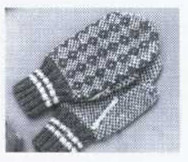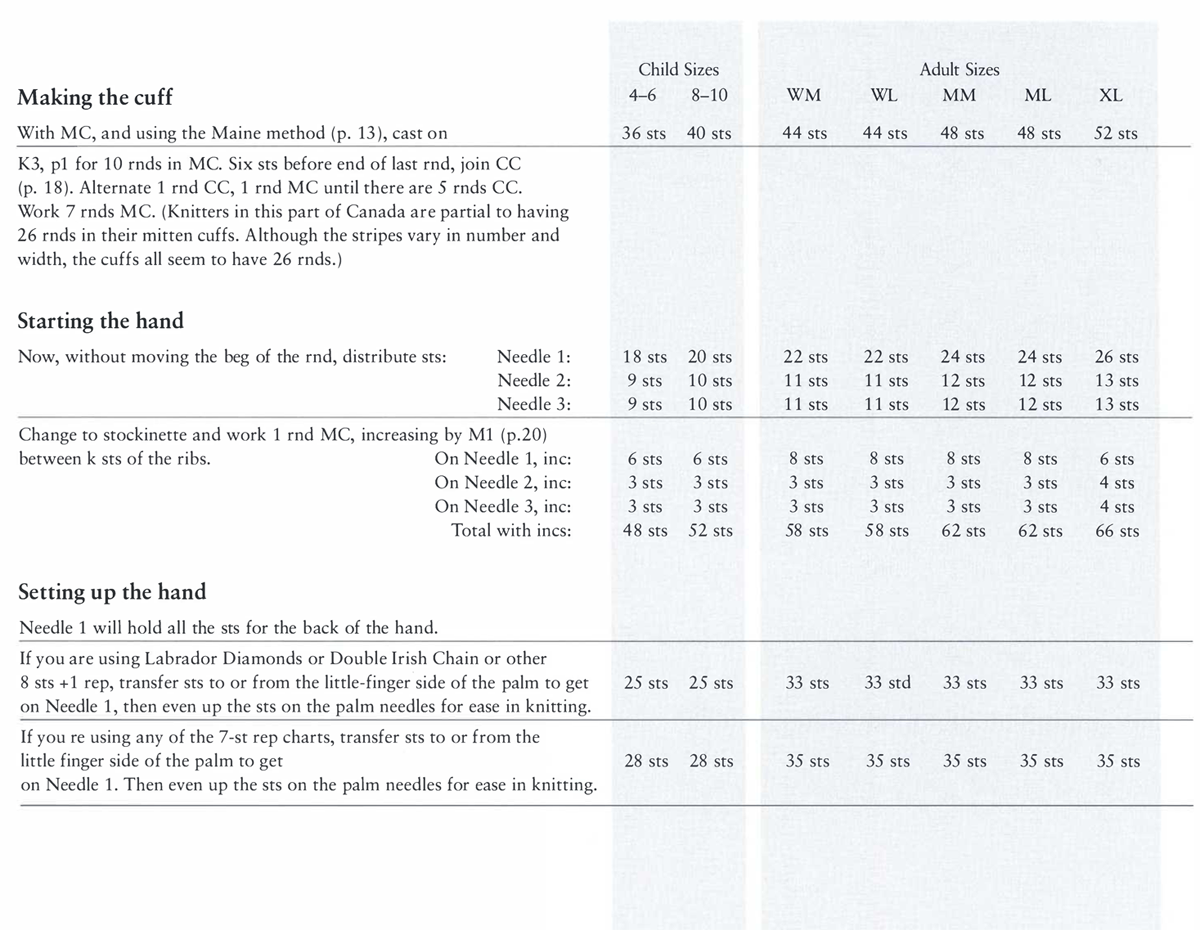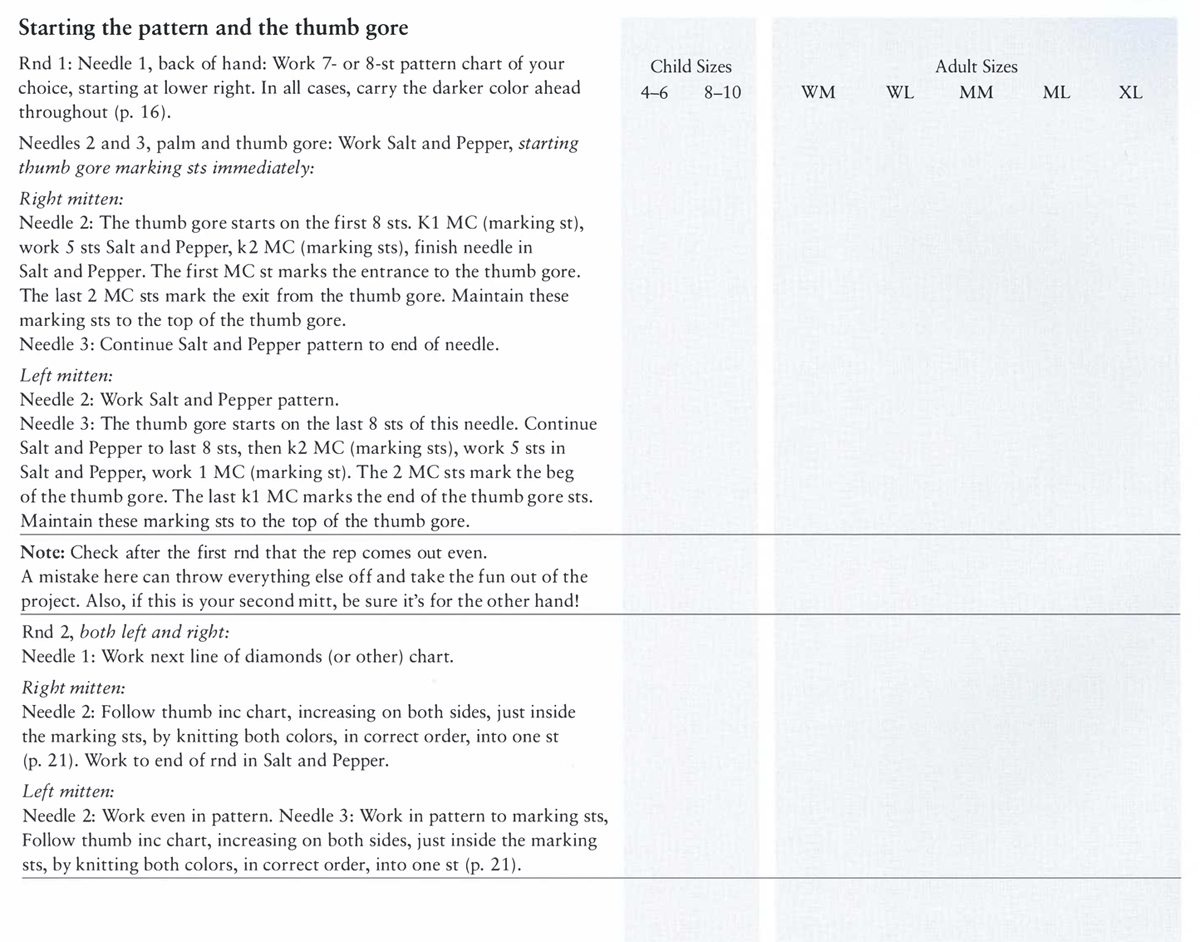
This design was taken from a child’s mitt knitted in the Saint Anthony’s area of Newfoundland, but all the families I met in Happy Valley, Labrador, had similar mittens, so the name is not far off base.
Usually the design is knitted only to the base of the fingers, with a modified Salt and Pepper pattern from there to the tip of the mitten. On this mitten, I’ve carried the design all the way up the fingers because it looks smashing that way. I hope that’s an adequate excuse for changing someone’s traditional design slightly.
Since learning this pattern, I saw in Ann Feitelson’s The Art of Fair Isle Knitting (Interweave, 1996) that similarly shaped mittens have been handed down in families on the Shetland mainland, “made by households for their own use, for wear and warmth, and not for sale.” On the Shetland mittens, the back pattern was carried all the way to the fingertips.
Double Irish Chain (p. 181), also an 8-st pattern, can be substituted for Labrador Diamonds on this mitten without any other changes. If you wish to substitute any of the 7-st patterns from the other Newfoundland-Labrador patterns (e.g., one of the Diamond Checks on p. 167), adjust the number of sts on the back of the mitten by taking sts from the palm on the little-finger side.
The decs are worked on both edges and in every rnd.

Labrador Diamonds Mittens with an outlined thumb gore and Salt and Pepper pattern on palm and thumb
Yarn For a lightweight mitten, use Briggs & Little 2/12, McAusland’s 2-ply Fine, or other DK or medium weight yarn. For a heavier mitten with the same tension, I use Bartlettyarns 2-ply Fisherman or Rangeley. Briggs & Little 2/8 also works well. For 1 pair you will need about
| MC | (oz) | 2 | 2¼ | 2½ | 2½ | 2¾ | 2¾ | 3 |
| (g) | 57 | 64 | 71.25 | 71.25 | 78.5 | 78.5 | 85.5 |
| CC | (oz) | 1½ | 2 | 2¼ | 2¼ | 2¼ | 2¼ | 2¾ |
| (g) | 42.75 | 57 | 64 | 64 | 64 | 64 | 78.5 |
Equipment 1 set Size 4 (3.5mm, Can. Size 9) double-pointed needles, or size you need to knit in Salt and Pepper pattern at correct tension • 12 ” (30cm) length of contrasting waste yarn • Blunt-tipped yarn needle
Tension 6½ sts and 7 rnds = 1 ” (2.5cm) in Salt and Pepper pattern

ABBREVIATIONS beg: beginning • CC: contrast color • dec(s): decrease(s) • inc(s): increase(s) • k: knit • k2tog: knit 2 together • MI: make 1 stitch • MIL: make 1 stitch left • MIR: make 1 stitch right • MC: main color • p: purl • rep: repeat • rnd(s): round(s) • SSK2tog: slip, slip, knit 2 sts together • st(s): stitch(es) • twisted MI: twisted make 1 cast-on
Measurements—inches and centimeters
| Child Sizes | Adult Sizes | |||||||
| 4–6 | 8–10 | WM | WL | MM | ML | XL | ||
| Length of hand | 5½ | 6½ | 7 | 7½ | 7 | 7½ | 8½ | |
| 14 | 16.5 | 17.75 | 19 | 17.75 | 19 | 21.5 | ||
| Hand circumference, incl. tip of thumb | 7 | 8 | 9 | 9 | 9½ | 9½ | 10 | |
| 17.75 | 20.25 | 22.75 | 22.75 | 24 | 24 | 25.5 | ||
| Length of mitten hand | 6 | 7 | 7½ | 8 | 7½ | 8 | 9 | |
| 15.25 | 17.75 | 19 | 20.25 | 19 | 20.25 | 22.75 | ||
| Mitten thumb (⅓ hand) | 2 | 2⅜ | 2½ | 2⅝ | 2½ | 2⅝ | 3 | |
| 5 | 6 | 6.5 | 6.75 | 6.5 | 6.75 | 7.5 | ||
| Mitten width | 3½ | 4 | 4½ | 4½ | 4¾ | 4¾ | 5 | |
| 9 | 10.25 | 11.5 | 11.5 | 12 | 12 | 12.75 | ||
Newfoundland/Labrador mittens have a distinct front and back and are right or left mittens. Because it’s desirable to have the pattern on the back very flat with no sign of needle changes, I have followed Harriet Pardy Martin’s suggestion to put all the back sts on Needle 1 and the palm sts on Needles 2 and 3. The end of the rnd will fall on a pattern change at the edge of the hand, and there is no obvious joint at the end of the rnd. Give the two yarns a half twist together at the beginning of Needles 1 and 2 to emphasize the turn to the other side of the mitt. Carry the darker color ahead at all times (p. 16).
Use Salt and Pepper pattern for the palm and the thumb, but you are free to use either Labrador Diamonds or Double Irish Chain charts (p. 180) or any other 8-st + 1 rep without changes. I have provided adjustments in the directions to use the 7-st Diamond or Waves charts (under “Mrs. Martin’s Finger Mitts,” p. 167) for the back of the mitten. (It’s all right if the pattern on the back of the hand runs over slightly at the little finger edge of the hand but it should be knitted on Needle 1 only.)

Although many Newfoundland and Labrador mitts have only as much large pattern as would normally be found on the back of a glove, with the whole finger area in Salt and Pepper, I have continued the pattern to the fingertip. You are, of course, free to knit the finger area in Salt and Pepper. Some knitters find a four-by-four square of diamonds more balanced and appealing than a pattern covering the entire back of the mitten.
The cuff is worked in k3, p1 ribbing, a traditional ribbing for Newfoundland and Labrador. It is worked on the same size needles as the rest of the mitt, with sts added at the base of the hand to accommodate the different tensions of ribbing and stockinette.
The striped pattern on this cuff is typical but not universal. Optionally, knit the cuff plain or use another of the Newfoundland striping patterns. Cuffs on Newfoundland/Labrador mittens fit closely. I have loosened them up a little for ease in taking them on and off.






Labrador Diamonds Mittens with the Diamond Check #1 pattern from from Mrs. Martin’s Finger Mitts (p. 167) on the back
This pattern was first published in Needlecraft for Today, 1985.